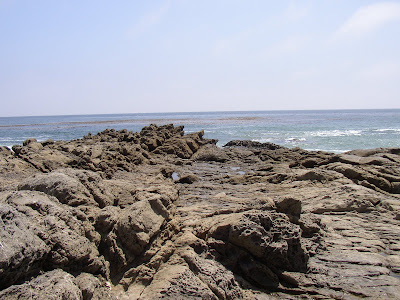Along some thirty-odd miles of coastline between Santa Monica and Santa Barbara, there are more than a dozen beaches where several memorable (and some not-so memorable) feature films have been shot. The Creature from the Black Lagoon (1954) first came ashore at Will Rogers Beach. Clarence and Alabama vacationed on El Matador State Beach at the end of Quentin Tarantino’s True Romance (1994). Frankie Avalon and Annette Funicello performed musical numbers on the Malibu beaches in AIP’s “lovably inane” Beach Party series, shot in and around Paradise Cove.
I confess I have never seen any of the famous Malibu beach party films – I prefer AIP’s experiments with Roger Corman, which brings us to the rocky shores of Leo Carrillo State Beach. This is where Corman directed portions of Attack of the Crab Monsters (1954), The Saga of the Viking Women and Their Voyage to the Waters of the Great Sea Serpent (1957), and Jack Nicholson’s LSD opus The Trip (1967). The beach is also featured in the Corman-produced Monster from the Ocean Floor (1954), The Terror (1963), and Peter Bogdanovich’s Voyage to the Planet of Prehistoric Women (1968). (It’s also where Mr. Miyagi taught Daniel how to “crane kick” in The Karate Kid.)
Years of erosion have created sea caves in the rock just below Lifeguard Station #3 – making it look like the perfect place to find a prehistoric crab monster… or hide from a prehistoric monster (see the 1959 adaptation of Journey to the Center of the Earth)… or bury a body (Benicio del Toro ended up here at the end of The Usual Suspects). Independent of their ominous screen history, the caves convey a real sense of danger during high tide. I couldn’t help thinking of a segment I produced for Survive This!, about an unwitting tourist who got swept into a sea cave off the coast of Oahu and couldn’t get out: the incoming waves kept slamming him against the jagged rock wall at the back of the cave until he was too tired to swim out. Thankfully, when we visited Carrillo State Beach, the tide was low… so we walked right into the caves.
Further south, we visited Point Dume – the site of one of film history’s most iconic moments. Point Dume is a 35-acre natural preserve, sitting on top of a 200-foot-tall triangular headland that juts out into the ocean. On the north side is Zuma Beach, which has been featured in the finales of several offbeat films: Robert Aldrich’s classic film noirs Kiss Me Deadly (1955) and What Ever Happened to Baby Jane? (1963), and the Coen Brothers’ Barton Fink (1993) and The Big Lebowski (1998). On the south side is Pirate’s Cove, recognizable as “the forbidden zone” from the closing moments of Planet of the Apes (1968). At the far south end of the cove is the site where Charlton Heston saw the remains of the Statue of Liberty.
We took a long, winding way home on Mulholland Highway, to catch a glimpse of one more famous filming location. Malibou Lake sits in the center of an exclusive neighborhood, not far from the Paramount Ranch. It looks just as serene as it did in James Whale’s Frankenstein (1931), when the Monster accidentally drowned an innocent girl there.
That’s a lot of film history to cover in one day, but it barely skims the surface of Hollywood Escapes.

Malibou Lake

Leo Carrillo State Beach


Corman’s Cave



Westward Beach

Pirate’s Cove (looking south)

north end of Pirate’s Cove

view from above

south end of Pirate’s Cove
No comments:
Post a Comment